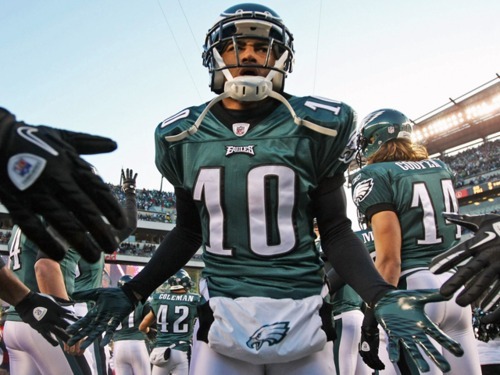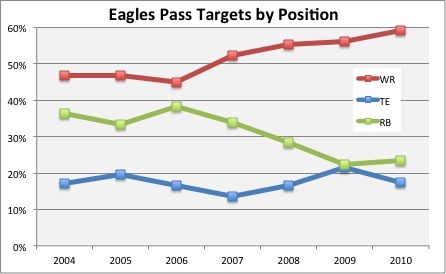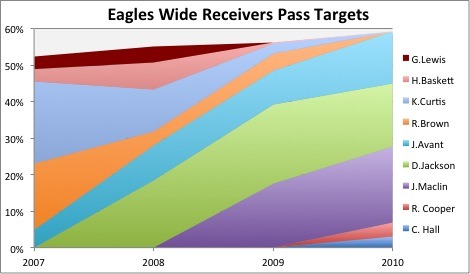
Before the 2010 season began, I examined the Eagles passing offense and how it had changed over the years, both in regards to pass targets by position and by player. At the time, we were considering the impact the switch from Donovan McNabb to Kevin Kolb would have on the Eagles passing attack. Of course, that didn’t exactly go as planned, and now we look back on season one of the Michael Vick era.
Let’s start by breaking down the pass targets by position (from Advanced NFL Stats):

As you can see, for the fourth straight season the wide receivers’ share of the pass targets has increased — to 59 percent of all passes, the highest point in the last decade. That long-term trend corresponds with both an increase in receiving talent (DeSean Jackson, Jeremy Maclin, and Jason Avant are easily one of the best starting groups in the NFL) as well as the decline of Brian Westbrook from his peak in 2006 and 2007, when he was the focal point of the entire offense.
LeSean McCoy brought up the pass targets to running backs in 2010, but only slightly. Meanwhile, Brent Celek’s role in the offense declined with Vick at the helm, bringing down the tight end position.
The ultimate takeaway here is that with Vick’s powerful arm and a set of explosive wide receivers on the outside, the focus on a down-the-field, receiver-centric passing attack is only likely to increase.
But taking on the wide receivers individually, we can see some other interesting trends:

This chart may seem visually complicated at first. Each wedge or section indicates the percent of pass targets a player received in a given year. Looking just at 2010, for example, we see that newcomers Riley Cooper and Chad Hall had minimal impact, while Maclin, Jackson, and Avant each carved out a sizable portion of the targets. Over time, the shifts in emphasis as the sections wax and wane become clear as well. Both Maclin and Avant had increased targets, while Jackson fell off a bit from his high in 2009.
Maclin actually was the most-targeted Eagle in 2010, with almost 21 percent of passes going his way. Jackson basically swapped spots with him, posting 17 percent. DeSean did miss one game, but overall he was just less reliable than Maclin last year. While in all but three games Maclin at least four receptions, Jackson had eight games in which he had less than that.
The fact that Maclin is now targeted more than Jackson doesn’t mean that he’s the Eagles new number one receiver, because pass targets aren’t everything. DeSean outpaced him with a huge 11 yards per target (tied for best in the league), compared to Maclin’s 8.5. He remains the more dangerous weapon, and the one opponents will game plan heavily to stop. Still, it’s an interesting fact to keep an eye on.
It also remains to be seen how much a player like Cooper can break into this three-man logjam at the top of the Eagles receiving corps. The rookie showed some promise in 2010, but will likely need injuries ahead of him to get any extensive playing time.
Overall, assuming the team signs DeSean Jackson and Michael Vick to new long term deals, an Eagles passing attack focused on wide receivers should be explosive and exciting for years to come.
Originally published at NBC Philadelphia. Photo from Getty.